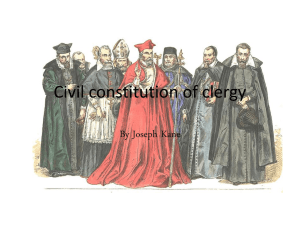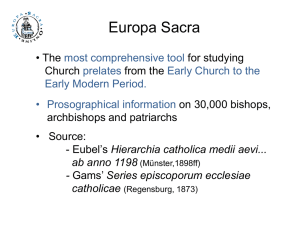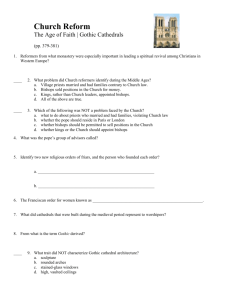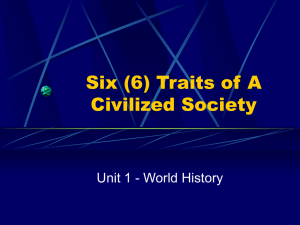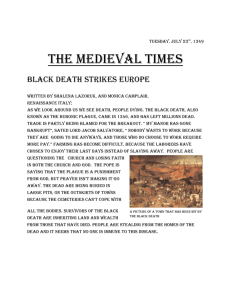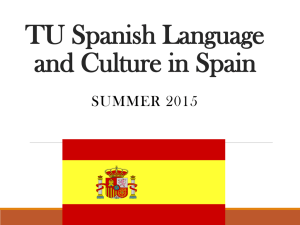Spanish Martyrs 01 - Missionary Oblates of Mary Immaculate
advertisement
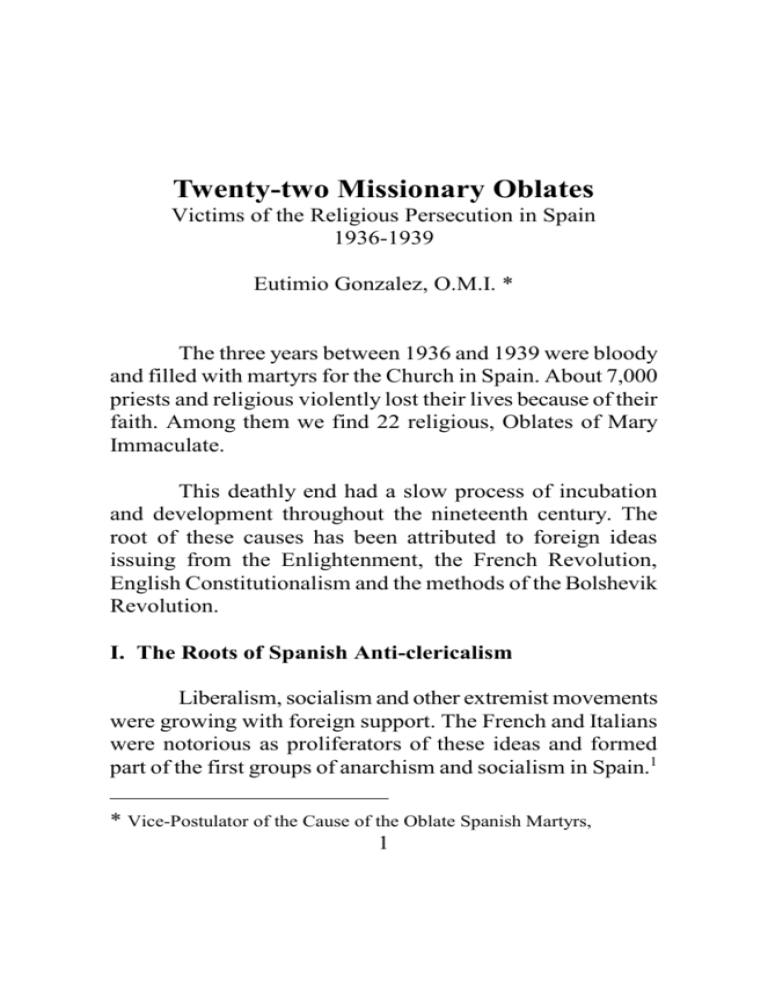
Twenty-two Missionary Oblates Victims of the Religious Persecution in Spain 1936-1939 Eutimio Gonzalez, O.M.I. * The three years between 1936 and 1939 were bloody and filled with martyrs for the Church in Spain. About 7,000 priests and religious violently lost their lives because of their faith. Among them we find 22 religious, Oblates of Mary Immaculate. This deathly end had a slow process of incubation and development throughout the nineteenth century. The root of these causes has been attributed to foreign ideas issuing from the Enlightenment, the French Revolution, English Constitutionalism and the methods of the Bolshevik Revolution. I. The Roots of Spanish Anti-clericalism Liberalism, socialism and other extremist movements were growing with foreign support. The French and Italians were notorious as proliferators of these ideas and formed part of the first groups of anarchism and socialism in Spain.1 * Vice-Postulator of the Cause of the Oblate Spanish Martyrs, 1 The most negative aspect of this influence occurred in the religious setting. The proletarian class, miserable and not cared for, began to emancipate itself from the Church seeking other redemptive means. The new politico-social situation was being identified with irreligiosity, anticlericalism and persecution.2 Historian V. Palacio Atard affirms that anticlericalism in Spain had two sources: an intellectual root, fruit of liberal subjectivism and scientific positivism and another popular source of enormous passionate force stimulated by revolutionary agents.3 Madrid. The original Spanish text, including the quotes from Spanish authors, was translated into English by David Muñoz Lopez, O.M.I. 1 M. Fernandéz Almagro, Historia política de la España contemporánea. Madrid, Ediciones Pegaso.1956, 3. 2 Llorca-Villoslada-Laboa. Historia de la Iglesia Católica V, B.A.C. 1980, 573. 3 V. Palacio Atard, citado por Vicente Cárcel Ortí, Mártires Españoles del siglo XX. B.A.C. Madrid 1995, 52. 2 Vicente Cárcel Ortí adds: A The two anticlerical currents advanced simultaneously, and acting together with the orators and demagogues were the tribunals of the plebs, directly responsible for the street disturbances and assaults on the people. This spirit was also fostered within the literary world: newspapers, magazines, plays and other writings brought to popular environments, among the obscenities, blasphemies and every genre of liberties and vulgarities, stereotypical and false images of a Church that was solely responsible for all the social evils of Spanish society and, as a consequence, worthy of the greatest punishment. Nobody was, therefore, surprised that the Republic arrived impregnated with and anticlericalism that had deep roots in the Hispanic society.@4 The phrase Areligion is the opium of the people@ was repeated ad nauseam among the popular Spanish class; it presented the Church as an ally to power and cause of all social evils. AThere is nothing sacred on earthY The people are slaves to the Church. The Church must be destroyed,@ were the words of Alejandro Lerroux, the future head of the 4 V. Cárcel Ortí, Mártires españoles del siglo XX. Madrid, B.A.C. , 1995, 53-54. 3 government, in 1936 in one of his exhortations to the AJóvenes bárbaros@, as cited by V. Palacio Atard. II. Consequences of Anti-clericalism: Aggression Towards the Church During the 19th century and the first three decades of the 20th century hostility towards the Church was frequent: the confiscation of ecclesiastical goods reached a high point, there were deportations of bishops and priests, the expulsion of the Jesuits, the rupture of relations with the Holy See, burning of churches and convents and the assassination of priests and religious. The rejection of the Church reached ridiculous extremes. Already in 1854, General Espartero, temporary governor, in tune with his sectarian anticlericalism and terrorizing the religious sentiments of Spanish Catholics, refused to allow the publishing of the Papal Bull fon the occasion of the Dogma of the Immaculate Conception. The institutional animosity contaminated the people who reacted with violent and bloody acts. AIt was enough for a malicious brain to idealize the calumny that friars were poisoning the public fountains, as a cause for the cholera that was decimating the Spanish population, that the masses would throw themselves at what was called Aa sin of blood@. On July 17, 1834, almost100 religious perished in 4 Madrid, brutally assassinated, among them Jesuits, Dominicans, Franciscans and Mercedarians. From the courts more sectarian regulations were emanating: the majority of religious communities were suppressed; the Jesuits were expelled again; the bishops were forbidden from conferring holy orders and many of them were thrown out of their dioceses. Neither the Pope=s protests nor the apostolic nuncio were able to abate such a turbulent wave. Things got worse during the three years between 1840-1843, during which Espartero [...] held the position of regent due to the voluntary exile of doña Maria Cristina [...] He closed the Nunciature, confiscations reached a climax. He persecuted bishops and pastors, naming intruders to replace them, he forbade the Work of the Propagation of the Faith and gave free range to the Protestants. Condemnations against these measures against the Church in Spain came forth from all of Christianity, to the point that Gregory XVI published the encyclical Afflictas in Hispania res, asking the whole Catholic world to pray for the Spanish faithful. These, for their part, promoted tirelessly the active and passive resistance against the violent general who, on August 12, 1843, had to give up his power and flee to England. 5 The sectarian legislation subjected to harassment and sieges all that was considered vital in Christian life: the Pope, bishops, priests and religious. Eighteen bishops were persecuted by the government and forced to flee from their respective dioceses. Another seven bishops remained in their dioceses, but had their activities limited by government regulations. Between 1843 and 1847 a number of dioceses were left vacant due to the death of their prelates.5 Religious did not come much better before the laws. Soon after the publishing of the decree of confiscation that placed on sale all the goods that belonged to religious corporations, on March 8, 1836 was issued a decree of exclaustration by which were suppressed all monasteries, convents, congregations, community houses and the male religious institutions, including those of the clerics regular and of the four military orders and of Saint John of Jerusalem, which existed on the peninsula, adjacent islands and Spanish possessions in AfricaY@.6 5 Ricardo García Villoslada, Historia de la Iglesia en España, V. Madrid, B.A.C., 1979, 179 B 180. 6 Id., op. cit., 1979, 139 ss. 6 The revolutionary forces maintained their positions against the Monarchy and against the Church, which they considered to be its most faithful ally. Besides socialism there were also more radical groups: U.G.T. (Unión General de Trabajadores), C.N.T. (Confederación Nacional de Trabajadores) and F.A.I. (Federación Anarquista Ibérica). Every year that passed the pressure was stronger and finally exploded on April of 1931. The monarchy disappeared: King Alphonsus XIII was forced to abandon Spain and the Second Republic was proclaimed. The Monarchy had disappeared. The Church also had to be made to disappear. Anticlericalism moved on to generalized bloody deeds. III. The Church and the Republic On October 13, 1931, D. Manuel Azaña, the then minister of war and later head of the government and President of the second Republic, affirmed in a session of Congress: ASpain has stopped being Catholic.@7 This 7 Diario de sesiones del Congreso, 14 de octubre de 1931. 7 affirmation was not to ascertain a reality, but it could have been a declaration of intentions. The Church in Spain did not live any agonizing moment. It counted on more than 30,000 priests and 3,500 seminarians, religious congregations multiplied, catechetics was being renewed, parish missions were increasing, the structures of Catholic Action were growing; the Catholic Circles in the working class were gaining strength, Spiritual exercises and retreats spread rapidly and popular religiosity was strong. Judging by the deeds that happened all over, there was, as Mr. Azaña mentioned, an intention and a project to erase from the Spanish map the long centuries of Christian culture and life. Nevertheless, the Spanish Church=s attitude was one of respect and submission [...] Professor Juan María Laboa writes: AOn April 24, on instructions from Rome, Nuncio Tedeschini sent a note to the Spanish bishops in which he communicated: It being the wish of the Holy See I suggest to priests, religious and faithful of your dioceses to respect the constituted powers and to obey to maintain order and the common good.= The bishops= pronouncements were numerous. The Archbishop of Valencia, the Bishop of Sigüenza, the Bishop of Zamora and many others considered that 8 >it is duty to respect the new form of government=; the bishops of Avila and Oviedo promised exemplary obedience to the established authorities; the bishop of Palencia insisted that the forms of government are accidental and that the Church is indifferent to it; Cardinal Ilundain exhorted that, out of patriotism, the government be respected sincerely and that obedience be given to those things that do not oppose themselves to the divine laws and the rights of the Church. As a consequence, the common denominator of the documents and speeches of the bishops were characterized by an insistence on obedience, cooperation and respect to the constituted power. AMotivated by the surprise of change, due to fear and apprehension, out of conviction or due to the suggestions coming from Rome, the bishops, conscious of the difficulties, were willing to respect, accept and collaborate with the Republic.@8 IV. Systematic Agression Towards the Church Antireligious Propaganda 8 J.M. Laboa, La larga marcha de la Iglesia. Madrid, Artes Gráficas Benzal, 1985, 242. 9 Throughout all of Spain books, magazines, pamphlets proliferated that diffused slogans of the militant soviet atheism. In the centre of the cities, in the suburbs and the villages, spontaneous orators would stand up and, in their rallies, attack God, the Church, the bishops, priests and religious. Manifestations in which the cries of Adown@ and Adie@ were frequent, an amen to all sorts of rude comments against anything that had a religious sign. Antonio Montero writes: Those who saw the first Republican Days remember that with the propaganda of the new regime the rudest attacks against religion were mixed in the vulgar slang of the suburban and village rallies. Father Constantine Bayle mentions 146 antireligious journals that existed in Spain in 1936. Not all can be classified as propagating atheism neither were their virulence and lexicon the same. Madrid, Barcelona and Valencia were the most significant workshops of all this shady press, of a sick literary quality in many cases, and circumstances that favored the penetration into the more illiterate classY@9 9 A. Montero, Historia de la persecución religiosa en España. Madrid, B.A.C.,1998, 36-37. 10 Burning of Convents As an immediate result of the antireligious intoxication there were attacks on religious buildings, profanations of churches and the burning of convents which coincided on the same dates in many cities. Cárcel Ortí writes: On May 11, 12 and 13, not even a month after the proclamation of the Republic, in Madrid, Valencia, Alicante, Murcia, Seville, Malaga, and Cadiz the first violent manifestations of the unstoppable anticlericalism took place with assaults, ransacking, burning of churches, monasteries and convents which the public service officials did not forbid to the extent that the Civil Guard and the Firefighters stayed away. Almost one-hundred buildings were partially or completely destroyed.@10 A Sectarian Legislation On December 9 Congress voted and approved the new Constitution which surprised all the Spanish Catholics because it legislated in a very sectarian and antireligious 10 V. Cárcel Ortí, op. cit., 54-55. 11 manner and opened the door to other minor decrees which wounded the conscience of the Catholic people. On January 16, 1932 the national teachers received a circular letter from the general director of Primary Education which obliged them to remove from the schools any religious object because school should be lay, and, in applying article 43 of the constitution crucifixes were suppressed. This measure, although legal, provoked a great irritation among numerous Christian families which felt their faith profaned and threatened by the education of their children. On January 24 the Society of Jesus was dissolved, since article 26 of the constitution had declared the suppression of religious orders which, in addition to the three canonical vows, would impose upon its members another special vow of obedience to any authority other than the legitimate one of the State. On January 2 the divorce law was approved and on January 6 all the cemeteries were secularized. On March 11 Religion, as a subject, was suppressed in all academic centers. However, the most polemic of the legislative arrangements of the first two republican years was the Law of Religious Confessions and Congregations, approved by the courts on May 17, 1933, with great satisfaction to the leftist parties and published in the Gazette on June 3, which was later classified as Athe work of art of the Republic@. This innocuous law limited Catholic 12 worship and submitted it, in practice, to the control of the civil authorities, with an ample margin for personal arbitration of the municipal powers.@11 11 Id., op. cit., 60 B61. 13 Pope Pius XI expressed his concern in the encyclical Dilectissima Nobis published on June 3, 1933. The Pope made his the views of the bishops and ratified them with strong expressions: The Catholic Religion alone sees its teaching odiously watched, as well as its schools and other institutions. AEven religious Congregations are now stricken in an inhuman manner by these deplorable laws. Deprived of everything, they will not be able to pay taxes. The free will of founders and benefactors was openly violated through the seizure of buildings with the object of creating lay schools that are Godless.@ ABy taking out the Society of Jesus they hoped to destroy the faith and Christian morals of the Spanish nation and with that they tried to wound severely the very supreme authority of the Church.12 Rectifying is the business of the wise. In this case those responsible in the government did not have such wisdom. There stood up, yes, some voices asking for moderation, but they were drowned out by the cries of those who wanted a faster pace. Religious persecution continued to advance in a rushed rhythm. Taunts and a Climate of Terror In the cities, villages and businesses local committees were created characterized by their rejection of the Church 12 J.M. Laboa, op.cit., 245. 14 and everything that was religious. The more extreme unions took possession of the direction and put out revolutionary slogans as they filled the so-called Ahouses of the people with newspapers, books and proclamations saturated with falsities and calumnies that would move credulous and uneducated people to aversion and hate. The committees spearheaded the October 1934 revolution with strikes, provocations and violent actions. On February 16, 1936 when the Popular Front came to power, formed by communists, socialists and syndicates, provocative acts aimed against religious institutions were the part of the daily news. Cárcel Ortí writes in his book ASpanish Martyrs in the 20th century@: AAccording to official data collected by the Ministry of Governance, completed with others originating from the diocesan curia, during the first five months of the Popular Front government, many hundreds of churches were set on fire, sacked or affected by different attacks; some were seized by the civil authorities and registered illegally by the town. Dozens of priests were threatened and forced to leave their respective parishes, others were expelled violently; many rectories were set on fire and sacked and others passed to the local authorities; the same sort awaited many catholic centers and numerous 15 religious communities; in some villages in different provinces worship was not permitted or limited, forbidding sounding the bells, procession with the viaticum and other religious manifestations; some cemeteries and statues were also profanedY Stealing the Blessed Sacrament and the destruction of the Sacred species was frequent. Parodies of sacred carnivals were held in Badajoz and Malaga. Personal attacks affected many priests, for besides the seventeen dead, others suffered imprisonment, beatings and wounds. However, despite the threats, most priests remained faithful in their ministry with the consequential risk, while religious were expelled from all official centers. In many populations, the dismantling happened with the consent of the local authorities; in other places they forbade the defense of Catholics. In all parts the culprits remained unpunished. AA climate of terror was created in which the Church was the main object. To foster the hate and aversion against the Church false accusations multiplied and on May 14 word was circulating around Madrid that the Salesian sisters were giving children poisoned sweets, provoking the attack and burning of their school, with violent aggression towards the sisters, many of which were seriously wounded. The government attempted, in this circumstance, to clear up the situation and officially declared that the 16 accusations were false. All revolutionary actions and demagogic propaganda were successfully developed by extreme left groups: the anarchists with their union, the F.A.I.; the most radical socialists, with Largo Caballero, known as the ASpanish Lenin@ and the communists, with Stalin-like ideologies and methods. And all this exploded incited by the anticlerical and antichristian fear of the Masons. ATherefore, it is necessary to ask: Is it worth insisting that, on the margin of its own civil war and with its anticipation, the program of Church persecution was had been prepared.@13 When the war began in 1936 the committees launched themselves to the streets, uncontrollably. Every intoxication of lies and calumnies burst out ferociously and cruelly. The persecutors formed revolutionary committees which received many names: Milicias Armadas Obreras y Campesinas, Milicias de Vigilancia, Patrullas de Control, Guardia popular antifascista. They were, in fact, the material executors of the arrangements adopted in the highest political posts, which supplied even weapons to civilians and 13 V. Cárcel Ortí, op. cit., 72-73. 17 militants, the authors of the worst destruction and crimes. The slogan was, therefore, to destroy the Church. AAll these committees acted freely and totally unpunished, protected and authorized by the same political authorities. Detainment and executions took place without intervention of any judicial power, without giving the victims the possibility to defend themselves and without due process.@14 V. Martyrs of the Religious Persecution It is legitimate here to speak of martyrdom in its proper and authentic sense. On September 30, 1936 the bishop of Salamanca and later bishop of Toledo, Dr. Enrique Pla y Demiel, did so in a pastoral letter to his diocese.15 The same goes for 39 other Spanish bishops on May 1, 1937 in a collective letter directed to the bishops of the whole world16, and for Pope Pius XI on September 14, 1936 in an allocution to five hundred Spanish pilgrims.17 14 Ibid., 76-77. 15 See Appendix. 16 See Appendix. 17 See Appendix. 18 This is how it was understood by a good and faithfilled people that witnessed the events and now waits for the Holy Church to one day proclaim it such. In the religious persecution in Spain there were thousands of people who suffered violent death, who were tortured and faced firing squads solely because they were believers, because they wore a cassock or a religious habit, for being priest or religious with some pastoral activity in a parish, institution of learning or hospital, or for being fervent lay people committed to their faith in Jesus Christ. Antonio Montero, in his book on the history of the religious persecution in Spain (pg. 762), presents us with a statistic of 6,832 ecclesiastics sacrificed in the religious persecution. The members of the secular clergy, including twelve bishops and an apostolic administrator, numbered 4,184, that is 13% of the total number of clergymen. Among the religious there are 22 martyrs belonging to the Missionary Oblates of Mary Immaculate who constituted 36% of their Congregation residing in Spain. The martyred women religious numbered 283. It has not been possible to present an approximate number of lay Catholics assassinated for being believers as a consequence to their faith. In the chronology of events of the revolution, 33 priests and religious were counted among those sacrificed in the October 1934 Revolution; nine of them have already been beatified. Another 17 priests and religious were killed 19 between January 1 and June 18 of 1936 during the government administration of the Popular Front which consisted of all the parties of a Marxist affiliation. The persecution became bloodier beginning in the summer of 1936 and was relentless for more than a year. It began to subside in July 1937 because the credit of the Republican Government was affected greatly due to the collective protest of the Spanish bishops, complaints from the Holy See and the warnings from various European sectors. Cárcel Ortí in his book on the Valentian martyrs of the 20 century writes something that is valid also for the rest of Spain: th AMore than it being premeditated, the persecution developed in a cruel manner, because almost all assassinations were preceded by psychological and physical torture, mutilations, beatings, insults, etc., to such an extreme that the bishops, in their collective letter, declared: >we would have not found in the Roman Martyrology any form of martyrdom that has not been usedY not exempting crucifixion; nevertheless, there are new forms of torture that have been possible due to modern substances and machines=. All that, according to Pius XI, >with a hate, barbarity and ferocity that could not be believed possible in our century=. 20 AAnd returning to the religious character, it is necessary to insist once more that the sole reason for many of the condemnations was for being a priest, a religious or a nun=. Even if they had done good for the poor and needy, even if they had worked as laborers, with the elderly or the sickY AIn many cases it provoked a betrayal, retraction and abandonment of the faith. Many priests were killed because they would not blaspheme and the same happened with many lay people. Others had the exercise of their ministry thrown in their faces: the celebration of the Holy Mass, visits to the sick, the distribution of Holy Communion, the celebration of funerals, etc. Others were invited to violate the seal of confession, to step on the crucifix or on sacred images and were provoked to commit dishonest actions. The cruelty of these satires and humiliations can be made longer with thousands of other examples, but it is enough with the cases here mentioned to show the eminent antichristian character of the persecution and the blind obsession of the persecutors for all things holy.@18 18 V. Cárcel-Ortí - R. Fita Revert, Mártires Valencianos del siglo XX. Valencia, Edicep, 1998, 4042. 21 The project of annihilation of the Church was so generalized and so radical that in all Republican Spain Anot only was the priesthood suppressed and were churches closed or destroyed, but also, arriving at ridiculous extremes, in the names of places throughout Spain, be it in cities or small towns, any reference to religion was eliminated. Not one town, hill, river, borough, street or plaza kept its name if it made reference to God, the Blessed Mother, the saints, or any other thing that related to religion, no matter how small.19 VI. Religious Persecution and Martyrdom In Pozuelo de Alarcón In this general climate of hate and antireligious fanaticism it is necessary to place the martyrdom of 22 Missionary Oblates of Mary Immaculate from Pozuelo de Alarcón. Pozuelo de Alarcón was, in 1936, a town of about 2,000 inhabitants. It was made up of two population centres: the old town of farmers and a new quarter, mainly of labourers, created with the arrival of the railroad which was called, and continues to be called, the Station. Apart from 19 Ramón Salas Larrazábal, La Iglesia Católica y la guerra española. Fundación Friedrich, Instituto Fe y Secularidad. Documentos y Estudios, 69, p. 151. 22 agriculture, the town lived off various other industries. There was a chocolate factory, a regional slaughterhouse, a workshop for sleeping cars for the Northern train and another factory for curing leather. There was no lack of steelworkers, plumbers and construction workers. The labor unions F.A.I. and C.N.T. were able to penetrate the labor environment and began to spread republican and anticlerical slogans which had in their sights the Oblate friars. In the Station quarter the Missionary Oblates of Mary Immaculate acquired a farm in 1929 which had a large living space and was destined to become the Major Seminary. In the same quarter there were already three women religious congregations: the religious of Saint Joseph of Cluny who dedicated themselves to teaching, the Franciscan Missionaries of Good Counsel who ran an orphanage for abandoned girls, and the Servants of Mary Ministers of the Sick who had a convent that served as a retirement home for their elderly sisters and at the same time visited and cared for the sick of the town in their homes.20 In the first two centres the Oblate Fathers served as chaplains. At the convent of the Servants of Mary, Fr. 20 Cf. Matriten. Beatificationis seu Declarationis Martyrii Servarum Dei Aureliae Arambarri Fuente et III Sociarum, Positio super Martyrio. Roma, 2002, Informatio, p. 20. 23 Vicente Blanco ministered as a confessor for the sisters. The Oblates also went regularly to the neighboring parishes to help with funerals, hear confessions and preach, especially during Lent and Holy week. The Oblate seminarians taught catechism in preparation for First Communion in the two churches of Pozuelo, in Aravaca and in Majadahonda. During Lent they would prepare the adults for their Easter obligation. On the great festivities the Seminary choir would receive an invitation to sing the Mass and organize the processions, which they accepted whenever possible. In Pozuelo there was only one diocesan priest who was the pastor of the old city and who would help in the chapel of the AStation@ quarter. The Oblate priests would help celebrating the nine-o-clock Mass on Sundays and Feasts in the Parish of the Assumption and helping with funerals celebrated in the chapel in the Station quarter. All this apostolic activity that the Missionary Oblates of Mary Immaculate did in town was the reason for all the hopes the bishop of the Diocese of Madrid-Alcalá placed on the new Congregation of Mary Immaculate when, in response to a letter to the Apostolic Nuncio to Spain, he wrote that the new house of the Oblate Congregation would be very useful for the good of the diocese, that it would make a good impression on the people and would not create a problem for other religious institutions. At the same time this apostolic activity began to 24 disturb the socialists, communists and labor unions which had formed their committees in the AStation@ quarter. With great apprehensiveness they confirmed that the Afriars@ (as they were called) were the locomotive that moved the religious life in Pozuelo and its surroundings. It irritated them that the religious walked the streets in their cassocks and even with their crucifix visibly hanging on from their necks. The degree of irritation increased when they noticed that an Oblate priest would attend the meetings that the Catholic Railroad Workers would hold in the church buildings. Due to all these exclusively religious activities the seminary of the Missionary Oblates became increasingly hated by the Marxist groups. Something about this antireligious environment had created an intuition to the Apostolic Nuncio when he authorized the opening of a new house for the Oblates in Pozuelo and spoke of possible campaigns against religious Congregations. This general hatred had its first manifestation in May of 1931. It was on the occasion of the burning of convents in Madrid on May 11, 12 and 13. From Pozuelo one could see the smoke rising in the sky. These violent acts awoke in the Marxists of Pozuelo an instinct of revenge. The Oblate convent was already for them an obsession and a nightmare. The religious received threats and observed strange movements. Fearful of anything, the community Superiors opted for distancing themselves from the danger. The academic year was interrupted to transfer all to the north, near the border of France, to a house the Oblates had 25 in Urnieta near San Sebastián. The formators, seminarians and Brothers remained in Urnieta until September, away from the dangers at Pozuelo. But again threats appeared during the October 1934 Revolution. Pozuelo was a watchtower for Madrid. Every revolutionary slogan, every harassing phrase towards the Church and every provoking gesture had immediate resonance in the committees of Pozuelo which maintained a permanent belligerent attitude. The Oblate religious community did not allow itself to be intimidated. It took extreme measures of prudence, serenity, calm and a commitment to not respond to any provocative insult. And, of course, no religious took part in political activities, not even occasionally. However, they did maintain their program of spiritual and intellectual formation without renouncing the different pastoral activities that were part of the priestly and missionary formation program. Despite the fact that the revolutionary slogans were ever more aggressive, the Oblate Superiors did not imagine that things could get worse. They could not conceive that one day they could be victims of such hatred due to their faith in Jesus Christ and for being heralds of God. And when the seminarians, at the end of the academic year, proposed going home to their parents for some time, the formators preferred to stay in Pozuelo to maintain the community alive. 26 The first seven months in 1936 were very tense. With the electoral triumph of the Popular Front the hostility became permanent. Every weekend the Marxist youth, based at the park they called Font of Health next to the convent, would cry at the house door: U.H.P. Death to the friars! The oratory of the convent faced the street. At dusk every Saturday and Sunday they would sing Vespers and at nightfall Compline. In spring and summer the windows were kept open so that those outside could hear. Frequently good people would stop to listen to the beautiful singing. It would also happen that member of the Popular Front would come near to bother and cry, among curse words and blasphemies, AU.H.P. Down with the clergy! Fascists! Death to the Friars! Long live Russia! It simply threw in the faces of the religious the anticlerical slogans that they had received and assimilated well. According to those slogans the friars were enemies of freedom, oppressors of the people; they encouraged capitalism. And, to top it all, the members of the Pozuelo committee were convinced that the friars hid an arsenal of weapons and that, from their convent to the school of the women religious, they had dug a tunnel through which they passed unseen.21 21 About all this, and especially about the attacks on the convent, the arrest of the members of the community, 27 When the militants attacked the convent, the first thing they did was to look like crazy everywhere to gather the weapons and destroy the tunnel of evil. They were also convinced that the friars carried guns. This is how they explained the fact that one Father always walked always with his right hand in the pocket of his cassock. On July 20, 1936, once the barracks in Madrid gave up, the socialist and communist youth went to the streets and began again to burn churches and convents. The militants in Pozuelo did not falter and began their outrageous festival. They attacked the chapel in the the execution of the first group of Servants of God, the dispersion, the other arrest and execution of the rest of the Servants of God, we have valuable information from Fathers Delfin Monje, O.M.I. and Porfirio Fernández, O.M.I., who, as members of the Community, were direct witnesses, lived and suffered, in all their cruelty, the events they describe. See: Delfín Monje, O.M.I., El Calvario del Escolasticado de Pozuelo. Trabajo inédito mecanografiado a un espacio. 42 p., en cuartilla. Madrid. 1939. Porfirio Fernández, O.M.I., Mis vivencias durante la guerra. Trabajo inédito mecanografiado a un espacio. 33 p. Folio. Córdoba, Argentina, 1942. 28 AStation@ quarter; they brought out to the streets the sacred ornaments and images and set them on fire as they performed a great sacrilegious orgy. They then burnt the chapel and repeated the scene at the town parish. We have here the clear witness of Jesus Perez Garcia, who appeared before the First Territorial Military Tribunal in Madrid. In his declaration he denounced the acts of the red committee in Pozuelo de Alarcón., whose members Aordered the arrest of all elements of the right that led to the Church and, after giving them instruments, forced them to destroy the altars with weapons and to remove the images so that they could be burned in the townsquare.@22 22 Tribunal Militar Territorial Primero, Sumarísimo n1. 5455, folio 23 Vt1. 29 That same act, a living expression of a deep antireligious sentiment, appears ratified in the Report of the Pozuelo town council at the Getafe Court. Speaking of a detained neighbor of Pozuelo, Julian Moreno Moran, it affirms: AHe is a person with leftist ideologies, a member of the red committee of this village who was involved in plundering and forced, together with others, people of the right to throw out the saints of the parish church.@23 On July 22, at three in the afternoon, a nurtured contingent of militants, armed with rifles and guns, attacked the convent. They first arrested the religious, numbering 38, enclosed them in a room and kept them under close watch pointing weapons at them. It was a moment of great tension in which all believed they had reached the moment of death. In the nervous, rude and disorganized attitude of the militants they could not read anything else. The militants immediately set to look minutely for the weapons and the tunnel. All they found were religious paintings, images, crucifixes, rosaries and sacred ornaments. From the top floors everything was thrown down the stairwell to the floor below to be destroyed in the fire ablaze in the middle of the street. In the windows flags of the C.N.T. and the F.A.I. were burning. Soon, very soon, it would be the turn of those they hated so much. 23 Ibid, Sumarísimo n1. 58729, folio 73. 30 On July 24th, at three or four in the morning, the first executions were held. Without interrogations, with no accusations, no trial and no defense seven of the Oblate religious were called and separated from the rest. The first to be sentenced to death were: Juan Antonio Pérez Mayo, priest Manuel Gutiérriez Martín, subdeacon Cecilio Vega Domínguez, subdeacon Juan Pedro Cotillo Fernández, perpetually professed Pascual Aláez Medina, temporarily professed Francisco Polvorinos Gómez, temporarily professed Justo González Lorente, temporarily professed Among those called forth was also a layman, a neighbour of Pozuelo, Candido Castan San José, a Catholic father of a family and president of the Catholic Railroad Workers. With no explanation they were placed in two cars and taken to their martyrdom. For a long time it had not been discovered where they were shot to death. Today, thanks to documents found in the archives of the First Territorial Military Tribunal, in Madrid, we have found witness statements that ascertain that the execution took place in the Fieldhouse. Eladio Gomez Morata, in a declaration before the 31 Military Tribunal, affirms that on July of 1936: When the Glorious National Movement exploded, he was residing in Pozuelo de Alarcón, and when he presented himself before the revolutionary committee which was formed in the same town, he was given a gun and ordered that he lend his services as a guard in the convent of the Oblate fathers to prevent the escape of those who were insideY and he continued to be a guard at night for the Committee and at the plaza of the AStation@, remembering that one night he was on duty next to the employee house when he saw two tourist cars pass by with six or seven Oblate fathers guarded by Arturo Porras, Asprilla, Tomas Gamez (a) Maganda, the son-in-law of his Uncle Collado (the barber) and Eustaquio Del Barrio, discovering later that the friars, together with the inspector of the railroads with the surname Castan, were shot at the Fieldhouse by the aforementioned militants. The next day the rest of the Community was taken out of the convent, totaling approximately forty, and taken in two trucks to the General Security Command, escorted by Assault guards who presented themselves in the town for said purpose, but he ignored what happened to those mentioned.@24 24 Id., Sumarísimo n1. 5455, folio 242 vt1. 32 Jesus Perez Garcia affirms the same in his declaration: AAnother of the first stripping of rights committed by the above mentioned committee (the red committee of Pozuelo) was the arrest of the Franciscan Fathers at their convent in Pozuelo (he is referring to the Oblates, the only religious present in town) where the committee had installed itself, whose fathers, together with the inspector of the Northern Company surnamed Castan, were led to the Fieldhouse and there assassinated.@25 Juan Francisco Rodriguez, a neighbor of Pozuelo, appearing before the Municipal Judge of the same place, also attributes to Eladio Gomez Morata the Aseizure of the convent of the Oblate Fathers, who he detained together with others, assassinating them later at the Fieldhouse.@26 In the failed sentence against Luis Criado Portugues, the number 1 War Council declared how there were Aproven documents that the accused formed part of the revolutionary Committee of said place (Pozuelo), who approved numerous outrages among them the assassination of D. Candido Castan 25 Ibid., folio 23. 26 Ibid., folio 257. 33 and other religious, escorting them to be assassinated at the place of their execution.@27 Before the Getafe Court, Clemente Perez Macein affirms that Ahe is certain of having seen Julian Moreno, from the beginning of the Movement, going out to the streets as a militant with a gun and revolver, that he saw how Julian carried out various arrests, taking the Oblate fathers in a truck to the Fieldhouse where they were assassinated.@28 The rest of the religious remained detained in the convent and dedicated their hours of waiting to prayer and a good preparation for death. Somebody, probably the mayor of Pozuelo, communicated to Madrid the risk run by the religious, and on that very same day, July 24 at two in afternoon, a truck of Assault Guards arrived with the order to take the religious to the General Directorate of Security.29 The militants, seeing that the religious were escaping from their hands, yelled from a terrace and expressed their rage with insults and blasphemies. After the religious were taken to Madrid, the red militants turned the convent into a general barracks and into a jail for lay people from neighboring towns. There was also 27 Id., Sumarísimo n1.12433, folio14. 28 Id., Sumarísimo n1.58729, folio 28. 29 See note 21 above. 34 a summary trial for these lay people, with no judges nor defense, and 47 were shot. The procedure was: take them from the convent by night in groups of less than ten. The same process that was tried with the seven Oblates. It is most probable that they continued this procedure not to raise any suspicions, the committees acting on their own accord with no judicial intervention. There was a reign of terror in town and people did not dare talk or ask since everything could be interpreted as a hostile act. On July 25, the Oblates held at the General Directorate of Security, through some arrangements, were let free. They looked for refuge in particular houses, but in October they were again detained and taken to the jail in Modelo. There they underwent a slow martyrdom of hunger, cold and threats until fifteen of them reached their bloody end. On November 7 in Paracuellos de Jarama José Vega Riaño, priest and formator at the Seminary, and in Aldovea Serviliano Riaño Herrero, temporarily professed, were shot. Twenty days later it was time for thirteen other religious Oblates. The process was the same for all of them. There were no accusations, no trial, no defense, and no explanations. There was only the proclamation of their names through loudspeakers: Francisco Esteban Lacal, priest and Provincial. 35 Vicente Blanco Guadilla, priest and Superior of the Seminary. Gregorio Escobar García, priest ordained July 6, 1936. Juan José Caballero Rodríguez, subdeacon. Publio Rodríguez Moslares, perpetually professed. Justo Gil Pardo, deacon. Ángel Francisco Bocos Hernández, perpetuallyprofessed. Marcelino Sánchez Fernández, perpetually professed. José Guerra Andrés, temporarily professed. Daniel Gómez Lucas, temporarily professed. Justo Fernández González, temporarily professed. Clemente Rodríguez Tejerina, temporarily professed. Eleuterio Prado Villarroel, temporarily professed. It is known that on November 28, 1936 they were taken from their jail and led to Paracuellos de Jarama were they were executed. The lists of prisoners Ataken out@ from the jail in San Antón on November 27, 1936, that carried the order of Areleased@ which was in fact the order of Aexecution, give us the names of the 13 Oblates. Antonio Montero quotes also the names of the 13 Servants of God, Oblates, on the long list in which appear many ecclesiastics: 15 Hospitalers of Saint John of God (beatified by John Paul II in October 25, 1992), 13 Augustinians, 7 diocesan priests, 3 Salesians, 2 Brothers of the Christian Schools, one Dominican, one Paulist and a 36 Franciscan.30 It has not been possible to obtain information from eye-witnesses of the moment of execution of the Servants of God. As indicated by the same Antonio Montero, they are also included in the declaration which Jeronimo Blanco Dies, a security guard, sent at the insistence of Fr. Peral, stating the exit of all of them from prison. In the same jail they were rigorously searched, depriving them even of the most essential. They were then cruelly tied with their hands behind their backs. This was motive for one of them, I believe a serious religious, to make the others notice that this was the first step towards Calvary, the same thing they did to Jesus Christ. At that moment the militants of San Antón intervened. There were more than forty or fifty that came from outside, one of those responsible named Julian Otero Mendez, later a captain in the Red Army, who gave his services in the auxiliary battalion for fortifications, stationed at Nuevo Baztan.@31 It is believed that they died professing their faith and forgiving their executioners. We do know that none of the 22 Oblates, despite the psychological torture during their cruel captivity, was an apostate, nor denied their faith, nor denied 30 A. Montero, op. cit. pp. 341-342. 31 Ibid.,. p. 342. 37 having embraced their religious vocation. For this reason their families, their brother Oblates and the Christian people, knowing their faithfulness until death, have unanimously held them to be martyrs from the first instance and wish and ask God that the Church recognize and present them to all the faithful as authentic Christian martyrs. ***** Documents in Appendix Gathered in this appendix are various witnesses who denounced before the world the horrors of the religious persecution in Spain, 1936-1939. 1. Ambassador Labonne The ambassador of France Pierre Labonne, a very religious Protestant man, and a defender of the Republican cause, wrote to Mr. Delbos, minister of Foreign Affairs, on February 16, 1938, four months after his arrival in Spain: What a show! For almost two years, after the massive killings of the clergy, the churches remain devastated, empty, open to all winds. No care, no worship. No one dares come close to them. Among the noisy streets or deserted places, the religious buildings seem to be places of pestilence. Fear, rejection or indifference, averted gazes. The houses of Christ and his wounds remain as permanent symbols of revenge and hate. In the streets there are no religious habits, no servants of the Church, diocesan or religious. All the convents have suffered the same sort, friars, nuns, priests, have disappeared. Many of them died violently. Many others, thanks to 38 meritorious efforts of our consulates, were able to reach French territory, a port of grace and refuge desired by many Spaniards from the first days of the tragedy. By decree of men religion has ceased to exist. Every religious life has been extinguished under a shroud of oppression and silence. Through all the government declarations not one word; in the press, not one lineY@32 2. The Spanish Episcopate Paragraphs from the collective letter of the Spanish bishops to the bishops of the whole world. July 1, 1937. Judging globally the excesses of the Spanish communist revolution, we affirm that in the history of the western world no phenomenon can equal the collective insanity, or a similar load, produced in a few weeks, of attacks against the rights of God, of society and of the human person. It will not be easy, gathering the analogous acts and adjusting their characteristic traces for the composition of criminal figures, to find in history a time or a people that could offer us similar and as many outrages. We have made history, without the interpretation of a psychological or social character which claim a particular study. The anarchic revolution has been Aexceptional in history@. 32 Quoted by RAMON SALAS LARRAZÁBAL in la Iglesia Católica y la guerra civil española. Fundación Friedrich, Instituto Fe y Secularidad Documentos y Estudios, 9 pg. 147. 39 We add that the catastrophe produced in the people and affairs by the communist revolution was Apremeditated@. Shortly before the revolution, 79 specialized agitators arrived from Russia. The National Commission for Marxist Unification during those same days ordered the constitution of revolutionary militias in all towns. The destruction of churches, or at least their ornaments, was systematic. In the short span of a month they had rendered all houses of worship unusable. In 1931, the Atheist League had in its program an article which said: Aplebiscite about the destiny of churches and rectories@; and one of the provincial committees had this rule: AThe place or places destined until now for worship, will be destined to become collective warehouses, public markets, public libraries, bath houses or houses for public hygiene, etc., according to the needs of each town@. To eliminate those people considered as enemies of the revolution, they had previously drawn up Ablack lists@. In some the bishop was first on the list. Speaking about priests and the attitude of the people who wanted to save their pastor, a communist leader said: AWe have been ordered to eradicate his seed@. This is an eloquent proof that the destruction of churches and the killing of priests were universal, premeditated, and surprising in its high numbers. Although the data is still premature, we have counted 20,000 churches and chapels destroyed or completely stripped. Among the priests who were assassinated we count an average of 40% in those devastated dioceses; in some it reaches 80%. The diocesan clergy alone sums up to 6,000. They were hunted like dogs, they were chased over mountains; they were searched for relentlessly in every corner. They were killed without judgment the majority of times with no other reason than that of their social office. The revolution was very cruel. The forms of assassination took on the character of horrendous barbaric acts. We can calculate more than 300,000 lay people who succumbed to assassination, 40 solely for their political, and especially religious, ideals; in the first three months in Madrid more than 22,000 were assassinated. There are hardly any town where the most prominent members of the right were not eliminated, due to a lack of form with no accusation, no proof, and mostly no trial. Their satire: many had their limbs amputated or horrendously mutilated before being killed; their eyes were caved out, their tongues cut out, dissected, burnt or buried alive, or chopped to death. The maximum cruelty was exercised upon the ministers of God. Out of respect and charity we don=t want to mention any more. The revolution was inhumane. The purity of women was not respected, not even of those consecrated to God by vows. The tombs and cemeteries have been profanedY Above all, the revolution was Aantichristian@. We don=t believe that in the history of Christianity and in the span of some weeks an explosion of the sort has occurred in any form of thought, will and passion of the hate against Jesus Christ and his holy religion. Such has been the sacrilegious havoc the Church in Spain has suffered, that the delegate of the Red Spaniards sent to the Congress of Athose without God@ in Moscow, could say: ASpain has exceeded in many ways the work of the Soviets, since the Church in Spain has been completely annihilated@. The martyrs can be counted by the thousands; their witness is one of hope for our poor land. We would have not found in the Roman Martyrology any form of martyrdom that has not been used, not exempting crucifixion; nevertheless, there are new forms of torture that have been possible due to modern substances and machines 41 The hate towards Jesus Christ and the Virgin Mother is out of this world, and in the hundreds of stabbed crucifixes, in the brutally profaned images of the Virgin Mother, in the political writings of Bilbao in which the Mother of God was sacrilegiously blasphemed, in the infamous literature of the red trenches where the divine mysteries were ridiculed; in the reiterated profanation of sacred objects, we can imagine the hate of hell incarnate in our infamous communists: AI swore to take my revenge on you@ one of them told the Lord locked up in the Tabernacle; and pointing the gun shot at him saying: Surrender to the reds; surrender to Marxism.@33 3. Pope Pius XI Address of His Holiness Pope Pius XI in an audience given to 500 Spaniards. (September 14, 1936). You are here, dear children, to tell us of the great tribulation from which you come, a tribulation of which you bring signs and visible prints on yourselves and your belongings, signs and prints of the great battle of suffering which you have sustained, that made you a public spectacle before our eyes and those of the whole world; you have been stripped of everything, hunted and sought to be put to death in the cities and towns, in private homes and in the loneliness of the hills, just like the Apostle saw in the first martyrs, admiring and rejoicing at seeing them shout to the world that intrepid and magnificent word that acclaimed it unworthy to have them: Quibus non erat dignus. 33 Pastorales de la Guerra de España, Madrid, 1955. Reproducción íntegra de A. Montero, Historia de la persecución religiosa en España, 733- 735. 42 You come to tell us of your joy at being found worthy, as the first apostles were, to suffer pro nomine Jesu; your happiness, already exalted by the first pope, covered with humiliation because of the name of Jesus and for being Christians. What would he say that We could say in your praise, venerable bishops and priests, persecuted and insulted precisely ut ministri Christi et dispensatores mysteriorum Dei? All this is the splendor of Christian and priestly virtues, of heroism and martyrdom; true martyrs in all the sacred and glorious significance of the word, even in the most innocent of lives, of the venerable elderly, of the youth in their springtime, of the intrepid generosity which asks for a place in the chariots where the victims wait for the executionerY We can and should tell you, as the Apostle to our first predecessors in the glory of martyrdom, Amy joy and my crown@Y 34 4. Pope Pius XII Radio address to the Spanish people. (April 16, 1939). The tenacious propaganda and constant efforts of the enemies of Jesus Christ seem to have wanted to make Spain a supreme experiment of the dissolving forces that they have at their disposal spread throughout the whole world, and although it is true that the Omnipotent for now has not permitted that they succeed, he has tolerated at least some of the terrible effects so that the whole world could see how religious persecution, destroying the very basis of justice and charity, which are the love of God and respect of his 34 B.O. del Obispado de Pamplona, 1936. Quoted by A. Montero, op.cit., 741, 742. 43 holy law, could drag modern society to the unsuspecting abysses of innocuous destruction and passionate disharmony. And now, before the memory of the accumulated ruins of the bloodiest civil war that modern history remembers, We, with a pious impulse, bow, above all, our forehead to the holy memory of the bishops, priests, religious of both sexes and faithful of all ages and conditions who in great numbers sealed their faith in Jesus Christ and their love for the Catholic religion with bloodY35 5. Pope John Paul II Decree of the Congregation for the Causes of the Saints (1992). 35 B.O. del Obispado de Pamplona, 1939. Quoted by A. Montero. op. cit., 744-745. 44 To the brilliant and glorious army of martyrs belong many Spanish Christians assassinated because of hatred towards the faith between the years 1936-1939, during the events of the civil war suffered by their nation, and because of the innocuous persecution brought against the Church, against its members and its institutions. Many bishops, priests and religious were persecuted with particular hatred and cruelty, their only faultCso it can be saidCwas to believe in Christ, to announce the Gospel and to lead a people down the road of salvation. With their elimination, the enemies of Christ and of his doctrine wished to make the Church disappear completely from Spanish soilY36 36 Decreto de los mártires de Almería. Quoted by V. Cárcel Ortí, op. cit., 24. Clement, here is the translation: “When we were “tasting” the moment in which they were going to kill us, we wanted to pronounce a prayer and nothing would come out, but, nevertheless, what did came out spontaneously were sentiments of love towards God, affection towards our brothers and pardon towards those that were going to kill us, and also a petition of pardon to God for our sins and weaknesses.” 45 46
